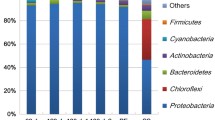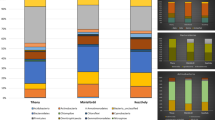Abstract
We analyzed the bacterial 16S rRNA gene diversity throughout the major components of the drinking water distribution system of a ca. 52,000-inhabitants city (Trikala City, Greece) in order to describe the changes of the bacterial assemblages and to detect possible bacterial pathogens which are not included in the standard monitoring process. Bacterial DAPI counts and DNA extraction was performed in the water pumping wells, the water treatment tank and tap water from households. Approximately 920 bp of the bacterial 16S rDNA were PCR-amplified, cloned, and sequenced for a total of 191 clones, which belonged to 112 unique phylotypes. The water of the pumping wells harbored a typical subsurface bacterial assemblage, with no human pathogens, dominated by β-Proteobacteria. Cell abundance in the water treatment tank decreased significantly, close to detection limit, but bacterial diversity remained high. However, the dominance of β-Proteobacteria decreased considerably, indicating the sensitivity of this group to drinking water disinfection treatment. Tap water from the households hosted a much less diverse, low-cell bacterial assemblage, dominated by Mycobacterium-like phylotypes, related to biofilm bacterial communities.
Similar content being viewed by others
References
Aronson, T., Holtzman, A., Glover, N., Boian, M., Froman, S., Berlin, O. G. W., et al. (1999). Comparison of large restriction fragments of Mycobacterium avium isolates recovered from AIDS and non-AIDS patients with those of isolates from potable water. Journal of Clinical Microbiology, 37, 1008–1012.
Aller, J. Y., & Kemp, P. F. (2008). Are Archaea inherently less diverse than bacteria in the same environments? FEMS Microbiology Ecology, 65, 74–87. doi:10.1111/j.1574-6941.2008.00498.x.
Berry, D., Xi, C., & Raskin, L. (2006). Microbial ecology of drinking water distribution systems. Current Opinion in Microbiology, 17, 297–302.
Böttger, E. C. (1991). Diagnosis and identification of Mycobacteria with PCR. Laboratory Medicine, 15, 414–419.
Call, D. (2005). Challenges and opportunities for pathogen detection using DNA microarrays. Critical Reviews in Microbiology, 31, 91–99. doi:10.1080/10408410590921736.
Colwell, R. R., Brayton, P. B., Grimes, D. J., Roszak, D. B., Huq, S. A., & Palmer, L. M. (1985). Viable but non-culturable Vibrio cholerae and related pathogens in the environment: Implications for release of genetically engineered microorganisms. Nature Biotechnology, 3, 817–820. doi:10.1038/nbt0985-817.
Covert, T. C., Rodgers, M. R., Reyes, A. L., & Stelma, G. N., Jr. (1999). Occurrence of nontuberculous mycobacteria in environmental samples. Applied and Environmental Microbiology, 65, 2492–2496.
Emtiazi, F., Schwartz, T., Marten, S. M., Krolla-Sidenstein, P., & Obst, U. (2004). Investigation of natural biofilms formed during the production of drinking water from surface water embankment filtration. Water Research, 38, 1197–1206. doi:10.1016/j.watres.2003.10.056.
Falkinham, J. O., III, Norton, C. D., & LeChevallier, M. W. (2001). Factors influencing numbers of Mycobacterium avium, Mycobacterium intracellulare, and other mycobacteria in drinking water distribution system. Applied and Environmental Microbiology, 67, 1225–1231. doi:10.1128/AEM.67.3.1225–1231.2001.
Good, I. J. (1953). The population frequencies of species and the estimation of population parameters. Biometrika, 43, 45–63.
Hilborn, E. D., Covert, T. C., Yakrus, M. A., Harris, S. I., Donnelly, S. F., Rice, E. W., et al. (2006). Persistence of nontuberculous mycobacteria in a drinking water system after addition of filtration treatment. Applied and Environmental Microbiology, 72, 5864–5869. doi:10.1128/AEM.00759-06.
Hurst, C. J., Crawford, R. L., Knudsen, G. R., McInerney, M. J., & Stetzenbach, L. D. (2002). Manual of environmental microbiology (2nd ed.). Washington DC: American Society for Microbiology Press.
Hussong, D., Colwell, R. R., O’Brien, M., Weiss, E., Pearson, A. D., Weiner, M., et al. (1987). Viable Legionella pneumophila not detectable by culture on agar media. Nature Biotechnology, 5, 947–950. doi:10.1038/nbt0987-947.
Kemp, P. F., & Aller, J. Y. (2004). Estimating prokaryotic diversity: When 16S rDNA libraries are large enough? Limnology and Oceanography, Methods, 2, 114–125.
Koneman, E. W., Allen, S. D., Janda, W. M., Schreckenberger, P. C., & Win, W. C. (2004). Color atlas and textbook of diagnostic microbiology (5th ed.). New York (NY): Lippincott.
Lane, D. J. (1991). Nucleic acids techniques in bacterial systematics. New York (NY): Willey-Interscience.
LeChevallier, M. W., Welch, N. J., & Smith, D. B. (1996). Full-scale studies of factors related to coliform regrowth in drinking water. Applied and Environmental Microbiology, 62, 2201–2211.
Le Dantec, C., Duguet, J.-P., Montiel, A., Dumoutier, N., Dubrou, S., & Vincent, V. (2002). Chlorine disinfection of atypical mycobacteria isolated from a water distribution system. Applied and Environmental Microbiology, 68, 1025–1032. doi:10.1128/AEM.68.3.1025-1032.2002.
Lipponen, M. T. T., Martikainen, P. J., Vasara, R. E., Servomaa, K., Zacheus, O., & Kontro, M. H. (2004). Occurrence of nitrifiers and diversity of ammonia-oxidizing bacteria in developing drinking water biofilms. Water Research, 38, 4424–4434. doi:10.1016/j.watres.2004.08.021.
Loy, A., Beisker, W., & Meier, H. (2005). Diversity of Bacteria in natural mineral water after bottling. Applied and Environmental Microbiology, 71, 3624–3632. doi:10.1128/AEM.71.7.3624-3632.2005.
Lu, H.-Z., Weng, X.-H., Zhu, B., Li, H., Yin, Y.-K., Zhang, Y.-Z., et al. (2003). Major outbreak of toxic shock-like syndrome caused by Streptococcus mitis. Journal of Clinical Microbiology, 41, 3051–3055. doi:10.1128/JCM.41.7.3051-3055.2003.
Maidak, B. L., Cole, J. R., Lilburn, T. G., Parker, C. T., Jr., Saxman, P. R., Farris, R. J., et al. (2001). The RDP-II (Ribosomal Database Project). Nucleic Acids Research, 29, 173–174. doi:10.1093/nar/29.1.173.
Martiny, A. C., Albrechtsen, H.-J., Arvin, E., & Molin, S. (2005). Identification of bacteria in biofilm and bulk water samples from a nonchlorinated model drinking water distribution system: Detection of a large nitrite-oxidizing population associated with Nitrospira spp. Applied & Environmental Microbiology, 71, 8611–8617. doi:10.1128/AEM.71.12.8611-8617.2005.
Pace, N. R. (1997). A molecular view of microbial diversity and the biosphere. Science, 276, 734–740. doi:10.1126/science.276.5313.734.
Peters, M., Müller, C. S., Rüsch-Gerdes, S., Seidel, C., Göbel, U., Pohle, H. D., et al. (1995). Isolation of atypical mycobacteria from tap water in hospitals and homes: Is this a possible source of disseminated MAC infection in AIDS patients? The Journal of Infection, 31, 39–44. doi:10.1016/S0163-4453(95)91333-5.
Porter, K. G., & Feig, Y. S. (1980). The use of DAPI for identifying and counting aquatic microflora. Limnology and Oceanography, 25, 943–948.
Regan, J. M., Harrington, G. W., Baribeau, H., Leon, R. D., & Noguera, D. R. (2003). Diversity of nitrifying bacteria in full-scale chloraminated distribution systems. Water Research, 37, 197–205. doi:10.1016/S0043-1354(02)00237-3.
Sen, K., & Rodgers, M. (2004). Distribution of six virulence factors in Aeromonas species isolated from US drinking water utilities: A PCR identification. Journal of Applied Microbiology, 97, 1077–1086. doi:10.1111/j.1365-2672.2004.02398.x.
Spiegelman, D., Whissell, G., & Greer, C. W. (2005). A survey of the methods for the characterization of microbial consortia and communities. Canadian Journal of Microbiology, 51, 355–386. doi:10.1139/w05-003.
Stackebrandt, E. (2006). Molecular identification, systematics, and population structure of prokaryotes. Berlin: Springer.
Staley, J. T., & Reysenbach, A.-L. (2002). Biodiversity of microbial life. Foundation of earth’s biosphere. New York (NY): Wiley-Liss.
Steed, K. A., & Falkinham, J. O., III. (2006). Effect of growth in biofilms on chlorine susceptibility of Mycobacterium avium and Mycobacterium intracellulare. Applied and Environmental Microbiology, 72, 4007–4011. doi:10.1128/AEM.02573-05.
Szewzyk, U., Szewzyk, R., Manz, W., & Schleifer, K. H. (2000). Microbiological safety of drinking water. Annual Review of Microbiology, 54, 81–127. doi:10.1146/annurev.micro.54.1.81.
Tamura, K., Dudley, J., Nei, M., & Kumar, S. (2007). MEGA4: Molecular Evolutionary Genetics Analysis (MEGA) Software Version 4.0. Molecular Biology and Evolution, 24, 1596–1599. doi:10.1093/molbev/msm092.
Tokajian, S. T. H., Fuad, A., Hancock, I. C., & Zalloua, P. A. (2005). Phylogenetic assessment of heterotrophic bacteria from a water distribution system using 16S rDNA sequencing. Canadian Journal of Microbiology, 51, 325–335. doi:10.1139/w05-007.
Torvinen, E., Suomalainen, S., Lehtola, M. J., Miettinen, I. T., Zacheus, O., Paulin, L., et al. (2004). Mycobacteria in water and loose deposits of drinking water distribution systems in Finland. Applied and Environmental Microbiology, 70, 1973–1981. doi:10.1128/AEM.70.4.1973–1981.2004.
Torvinen, E., Lehtola, M. J., Martikainen, P. J., & Miettinen, I. T. (2007). Survival of Mycobacterium avium in drinking water biofilms as affected by water flow velocity, availability of phosphorus, and temperature. Applied and Environmental Microbiology, 73, 6201–6207. doi:10.1128/AEM.00828–07.
WHO (2004). Guidelines for drinking water quality (3rd ed.). Geneva: World Health Organization.
WHO (2006). Guidelines for drinking water quality. Addendum to volume 1 (3rd ed.). Geneva: World Health Organization.
Williams, M. M., Domingo, J. W., Meckes, M. C., Kelty, C. A., & Rochon, H. S. (2004). Phylogenetic diversity of drinking water bacteria in a distribution system simulator. Journal of Applied Microbiology, 96, 954–964. doi:10.1111/j.1365-2672.2004.02229.x.
Yamazaki, Y., Danelishvili, L., Wu, M., MacNab, M., & Bermudez, L. E. (2006). Mycobacterium avium genes associated with the ability to form biofilm. Applied and Environmental Microbiology, 72, 819–825. doi:10.1128/AEM.72.1.819-825.2006.
Author information
Authors and Affiliations
Corresponding author
Electronic supplementary material
Below is the linked to the Electronic supplementary material.
Rights and permissions
About this article
Cite this article
Kormas, K.A., Neofitou, C., Pachiadaki, M. et al. Changes of the bacterial assemblages throughout an urban drinking water distribution system. Environ Monit Assess 165, 27–38 (2010). https://doi.org/10.1007/s10661-009-0924-7
Received:
Accepted:
Published:
Issue Date:
DOI: https://doi.org/10.1007/s10661-009-0924-7




